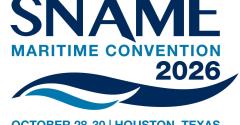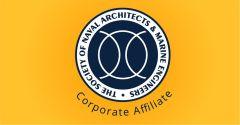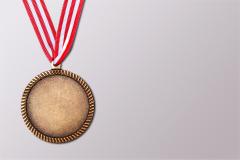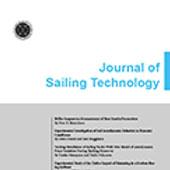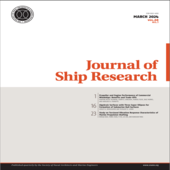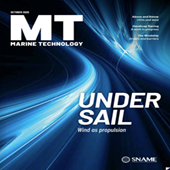Member Spotlight: Frederick (Rick) Ashcroft

Rick Ashcroft holds a unique position within SNAME. He is not only our Technology & Research Director (a staff position,) but he also volunteers in many other capacities, including as chair of the Marine Forensics Committee. Rick is the backbone of our SMC technical program — overseeing the panel session scheduling, ensuring that there are moderators for each panel, and making sure that it flows flawlessly. It is in this added light that we celebrate Rick’s 50 years of SMC attendance with his first-person Member Profile.
I joined SNAME 53 years ago when I took my first naval architecture class at the University of Michigan (U-M) in 1972. Professor John Woodward told us to join. “It’s your professional society – and you’ll want the discount on the books you’ll have to buy.” And he was right. I joined as a student, got that discount, and stayed for the fun! I recently realized that the first SNAME Maritime Conference (SMC) I attended was in 1975 as a student in U-M’s Quarterdeck Society; back then, it was called the Annual Meeting. In 1976, I went again, and I’ve found a way to attend every one since; SMC 2025 will be my 50th.
MENTORSHIP AND CONNECTION
That realization made me think about how I got to this milestone and what the journey has meant to me. During most of my 18 years at U-M, I worked in what was then called the Ship Hydrodynamics Laboratory (SHL), and I found that I loved model testing. In the days before Computational Fluid Dynamics (CFD), this was the most common way to solve the hydrodynamic puzzles that would provide owner/operators with the most efficient hull form possible within their design constraints. I am profoundly grateful that Professor Richard B. Couch, Director of the SHL, took me under his wing, providing a level of mentoring most people only dream of. We developed a relationship that extended beyond the laboratory to his extensive consulting. We supported many design efforts, but by the mid-1980s, the bulk of the work was forensic analysis – accident reconstructions. In addition to many dozens of small boat accidents, I worked on some better-known big ship accidents; the Exxon Valdez grounding and the Summit Venture-Sunshine Skyway allission were the two biggest. The accident reconstruction work got me interested in forensics, leading me to join the SNAME T&R Marine Forensics Committee many years later. I now chair that committee and look forward to our quarterly discussions on both historic (e.g., Titanic) and current studies. My years in model testing and more than a decade of full-scale structural instrumentation and sea trials projects made me a good fit for the T&R Program. For more than 30 years, I have been a member of many panels and committees and have chaired some of them. I also served a term as Functional VP of Technology – six of the busiest years of my life! Professor Couch always said SNAME membership was professionally important and would provide me with many opportunities on that front – he was absolutely right, and I have tried to share that philosophy with anyone who will listen.
WORK-LIFE BALANCE
Although I spend a lot of time working, I have many other interests. I love to sail, and from 1978 to mid-2024, my wife, Chris, and I owned a string of sailboats – the last was a Catalina 30 MK III that we had for 24 years. This year, we joined “The Dark Side” (you know – powerboats) and bought a 2023 Jeanneau nc795 that we can trailer to new adventures. I also love working behind the scenes on the technical side of theater productions. During my 20 years in Ann Arbor, I worked with the Ann Arbor Civic Theater, at first doing sound design and special effects. Later, I stage-managed all the theater’s Main Stage productions, was on the Board of Directors, and for 10 years was Vice President for Production, overseeing the 12-14 shows we did each year. I also worked with other local theater groups.
Since moving to California in 1991, I have been involved with several regional theaters, doing sound and lighting design as well as special effects. One of my favorite assignments was special effects for Charlie and the Chocolate Factory. Over the years, I have won “best of the season” awards for lighting and/or sound design and a few for special effects. At first glance, my theater work may seem surprising for someone with a “day job” as an engineer, but these pursuits are so complementary.
Being on the board of directors for a theater nonprofit requires both business and management skills I put to work regularly as an engineer. Stage-managing a live production with more than 70 actors, two dozen stagehands, and a full orchestra requires many of the same skills as managing field tests or trials – when things don’t go as planned, you need to be able to think fast and come up with a solution that keeps people safe and the project moving. Lighting, sound, and special effects are just plain fun – and require imagination, a basic understanding of the physics of light, acoustics, and engineering, as well as creativity within prescribed bounds ... Not so different from designing marine structures, model, and full-scale experiments after all. And like SMC, the theater provides endless opportunities to network. More than once when I needed specialist advice, I called one of the electrical or aerospace engineers who worked on a production with me.
Coming full circle, what is it about SNAME that has kept me involved since joining as a college student? The genuine pleasure I get from my association with so many smart and talented people has kept me coming back for five decades and will undoubtedly keep me involved for the foreseeable future. Ashcroft (right) costumed as “The Stage Manager,” a fun role in a 1990 production of Drood in Ann Arbor. He was the stage manager and assistant director for the production and was happy to make “art imitate life” and play the on-stage stage manager, too.


